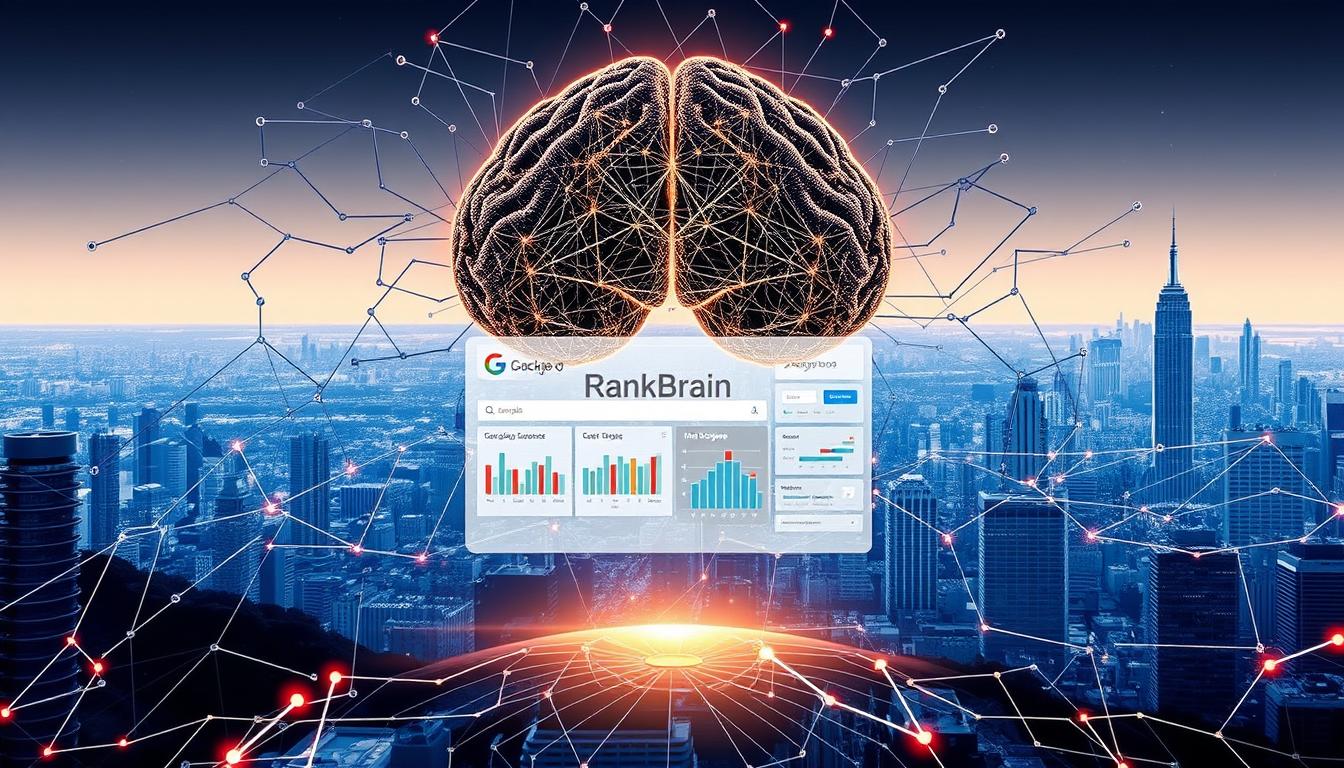
RankBrain is a cutting-edge AI algorithm developed by Google to enhance the interpretation of complex search queries. As a key component of Google’s search algorithm, it plays a pivotal role in modern SEO practices by analysing user interactions to refine search results. This machine learning system has revolutionised how search engines understand and rank content.
Originating from Google’s earlier PageRank system, RankBrain represents a significant evolution in SEO. It uses machine learning to interpret search queries more effectively, focusing on user intent rather than just keyword matching. This shift has transformed how SEO strategies are developed and implemented.
RankBrain’s primary function is to understand the context and intent behind search queries. By analysing factors like click-through rates and dwell time, it assesses the relevance of search results. For instance, a higher click-through rate and longer dwell times indicate content that is more relevant and useful to users. Conversely, a high bounce rate can negatively impact rankings.
Studies have shown that RankBrain can outperform human engineers by up to 10% in ranking search results. This highlights its effectiveness in improving search engine optimisation. As part of Google’s Hummingbird algorithm, RankBrain focuses on delivering more accurate and contextually relevant search results.
This guide will delve into the intricacies of RankBrain, exploring its impact on digital marketing strategies and providing actionable insights for optimising your content in the age of AI-driven search algorithms.
Introduction to RankBrain and Its SEO Impact
RankBrain represents a significant leap forward in how search engines interpret and process queries. By leveraging machine learning, it transforms the way content is ranked, focusing on user intent rather than just keywords. This shift has profound implications for SEO strategies, making it essential to adapt to these changes.
Setting the Context for Modern SEO
Traditionally, SEO relied on exact keyword matches. However, RankBrain’s introduction marked a shift towards understanding context. It now interprets complex queries, especially the 15% of searches that are entirely new, by analyzing signals like click-through rates and dwell time. This approach ensures that search results are more relevant and user-friendly.
Why RankBrain Became a Game-Changer
RankBrain’s ability to handle never-before-seen queries sets it apart. It refines search results in real-time based on user interactions, prioritizing content that aligns with search intent. This has led to more accurate and contextually rich results, benefiting both users and content creators. As we explore further, we’ll delve into how these advancements redefine SEO principles and strategies.
The Evolution from PageRank to Machine Learning
Google’s journey in search algorithms began with PageRank, a system that relied on link analysis to rank pages. Over time, this evolved into more sophisticated methods, culminating in RankBrain, which leverages machine learning to understand user intent.
History of Google’s Ranking Algorithms
In the mid-90s, Google introduced PageRank, revolutionizing search by prioritizing links. This laid the groundwork for future innovations.
The Hummingbird update in 2013 marked a shift towards natural language processing, enabling better handling of complex queries.
RankBrain, launched in 2015, integrated machine learning to interpret user intent, significantly enhancing search accuracy.
| Algorithm | Year Introduced | Key Focus | Impact on SEO |
|---|---|---|---|
| PageRank | 1996 | Link-based ranking | Emphasized backlink quality |
| Hummingbird | 2013 | Natural language processing | Boosted semantic search |
| RankBrain | 2015 | Machine learning, user intent | Enhanced contextual relevance |
This evolution from PageRank to RankBrain showcases Google’s commitment to understanding user intent, moving beyond mere keywords to deliver more relevant results.
What is RankBrain in SEO: A Deeper Look
RankBrain, launched in 2015, is a machine learning algorithm that refines how Google interprets search queries. It adjusts ranking signals based on user interactions, such as click-through rates and dwell time, over time. This adaptation allows the algorithm to prioritize content that better aligns with user intent.
By analyzing user behavior, RankBrain assesses content relevance. For example, a higher dwell time indicates engaging content, which the algorithm favors. Conversely, high bounce rates may lower rankings. This approach ensures search results are more aligned with what users are seeking.
Changes in user behavior prompt RankBrain to update its ranking signals. For instance, if users consistently engage more with certain content types, the algorithm adjusts to favor those. This continuous learning aspect means the algorithm evolves over time, improving search results based on real user interactions.
Understanding RankBrain’s mechanisms is crucial for modern SEO. It emphasizes the importance of focusing on user intent and content quality rather than just keyword optimization. By aligning content with user needs, businesses can improve their search rankings and visibility.
How RankBrain Works: Machine Learning and User Signals
Machine learning plays a pivotal role in RankBrain’s functionality. This advanced tool interprets complex search queries by converting keywords into concepts, allowing for a deeper understanding of user intent. For instance, when a user searches for “best Italian restaurants near me,” RankBrain identifies the intent behind the query, focusing on location and quality, rather than just matching keywords.
Decoding Machine Learning in Search
At its core, RankBrain operates as a machine learning system. It continuously learns from user interactions, such as click-through rates and dwell time, to refine search results. This learning process enables RankBrain to improve its accuracy over time, making it an essential tool for modern search algorithms.
Understanding User Experience Metrics
User experience metrics are critical signals for RankBrain. Bounce rate and dwell time are key indicators of content value. For example, if users spend more time on a page, it signals to RankBrain that the content is relevant and valuable. Conversely, a high bounce rate can negatively impact rankings. By aligning content with user behavior, businesses can enhance their SEO performance and improve search engine rankings.
Real-world examples demonstrate how improvements in user signals can lead to better rankings. For instance, optimizing titles and meta descriptions to increase click-through rates can significantly enhance a website’s visibility. Additionally, creating engaging content that keeps users on the page longer can improve dwell time, further boosting rankings.
Ultimately, RankBrain’s dual role in interpreting queries and measuring user satisfaction underscores the importance of aligning content with user intent. By leveraging machine learning tools and focusing on user experience metrics, businesses can create more relevant and engaging content, leading to sustained SEO success.
Optimising Titles and Meta Descriptions for Enhanced CTR
Optimising your title tags and meta descriptions is a proven way to boost click-through rates (CTR). By crafting these elements with care, you can significantly enhance how your content is perceived in search results. This section explores effective strategies to make your titles and descriptions more compelling.
Emotive Title Strategies
Creating emotional, engaging titles is key to capturing user attention. Emotional appeal can drive higher CTR by making your content stand out. For instance, using action-oriented language or highlighting benefits can make a significant difference. Data shows that emotional titles often perform better, encouraging users to click more frequently.
Using Brackets, Parentheses and Numbers
Incorporating brackets, parentheses, and numbers into your titles is a simple yet effective tactic. For example, a title like “10 Tips (You Need to Know)” can draw attention and improve CTR. Studies indicate that such formatting can increase engagement by up to 33%, making your content more appealing at first glance.
Meta descriptions also play a crucial role in supporting your title and providing context. By including relevant terms and maintaining a clear, concise structure, you can further enhance your content’s visibility and appeal. Remember, the goal is to create a compelling preview that invites users to click through and explore your content.
Keyword Research in a RankBrain World
Keyword research has undergone a significant transformation with the advent of RankBrain. This AI-driven algorithm has reshaped how we approach keyword selection, moving beyond traditional methods to focus on user intent and context.
Shifting Focus from Long-Tail to Medium Tail Keywords
Long-tail keywords, once a staple in SEO, have lost some effectiveness. RankBrain’s ability to group similar queries means targeting broader terms can capture more traffic. Medium-tail keywords, which are slightly broader, offer a sweet spot between specificity and reach.
- Long-tail keywords are less effective as RankBrain clusters similar queries.
- Medium-tail keywords capture broader intent, attracting more targeted traffic.
For instance, instead of “best Italian restaurants in London,” targeting “Italian restaurants London” can yield better results. This approach aligns with RankBrain’s understanding of intent, improving visibility and relevance.
Leveraging Searcher Intent in Keyword Selection
Understanding user intent is crucial. RankBrain excels at interpreting intent, so focusing on what users truly seek is key. Whether informational, navigational, or transactional, aligning keywords with intent enhances relevance and rankings.
- RankBrain interprets intent by analyzing user behavior and context.
- Content addressing specific needs ranks higher, as seen in real-world examples.
For example, a query like “how to make homemade pizza” indicates an informational need. Tailoring content to such intent ensures it meets user expectations, fostering engagement and better rankings.
By focusing on medium-tail keywords and user intent, businesses can create content that resonates with their audience. This strategic approach not only aligns with RankBrain’s capabilities but also enhances overall SEO performance, driving sustained success in search engine rankings.
Enhancing Content for Lower Bounce Rates and Increased Dwell Time
Engaging content is key to keeping users on your page longer and reducing bounce rates. By delivering value from the first sentence, you can capture attention and encourage deeper exploration.
Techniques to Hook Your Readers
Several strategies can help reduce bounce rates and boost dwell time. Short, engaging introductions and above-the-fold content that immediately addresses user needs are effective. Using subheaders and visuals breaks up text, making it easier to digest and share.
| Strategy | Effect |
|---|---|
| Engaging Hooks | Grabs attention, encourages reading |
| Short Intros | Provides immediate value, reduces bounce |
| Above-the-Fold Content | Keeps users engaged from the start |
Dwell time is crucial as it signals content value to RankBrain. Longer engagement indicates relevance, improving SEO performance. By focusing on user satisfaction, you create content that resonates, fostering a positive experience and better rankings.
Utilising LSI and Semantic Keywords for Richer Context
Latent Semantic Indexing (LSI) keywords and semantic phrases play a crucial role in enhancing the context of your content. By incorporating these elements, you provide search engines with a deeper understanding of your content’s subject matter, improving its relevance and visibility.
Identifying Relevant LSI Keywords
LSI keywords are terms related to your main keyword, helping search engines understand the context and intent behind your content. Tools like Google Keyword Planner and AnswerThePublic can help identify these keywords by revealing patterns in search queries. For example, if your main keyword is “Italian restaurants,” LSI keywords might include “authentic pasta dishes” or “wine pairings.”
Integrating Semantic Phrases Naturally
Semantic phrases are longer, more descriptive terms that align with user intent. Integrating these naturally within your content ensures it resonates with both users and search engines. For instance, instead of just “Italian restaurants,” you could use “best Italian restaurants near me” to capture location-based intent.
| LSI Keywords | Benefits | Examples |
|---|---|---|
| Contextual terms | Enhance content depth | Authentic pasta dishes |
| Semantic phrases | Align with user intent | Best Italian restaurants near me |
By strategically using LSI keywords and semantic phrases, you can improve your content’s relevance and ranking, ensuring it meets the evolving demands of search engines and user expectations.
Leveraging Topic Clusters and Pillar Pages
Creating a well-structured content system is essential for modern SEO strategies. Topic clusters and pillar pages form the backbone of this system, helping search engines like Google understand your site’s authority and depth on specific topics.
By organising content into topic clusters, you create a comprehensive ecosystem that signals expertise to search engines. Each cluster focuses on a specific topic, with pillar pages serving as central hubs that link to related subtopics.
Building a Comprehensive Content Framework
A pillar page broadly covers a main topic, such as “Italian restaurants,” while subtopics like “best pasta dishes” or “wine pairings” provide in-depth coverage. This structure not only enhances user experience but also improves your site’s visibility in search results.
- Topic clusters help search engines understand content relationships, boosting relevance and rankings.
- Pillar pages act as central resources, linking to diverse subtopics and enhancing site navigation.
- Aligning clusters with natural language mirrors user search patterns, capturing more conversational queries.
For example, a pillar page on “Italian restaurants” might link to subtopics like “authentic pasta dishes” and “wine pairings.” This approach not only aids user navigation but also signals authority to search engines, improving your site’s credibility and search rankings.
| Content Element | Benefit |
|---|---|
| Topic Clusters | Enhance content ecosystem and search engine understanding |
| Pillar Pages | Centralise resources and improve user navigation |
| Natural Language Alignment | Mirror user search patterns for better visibility |
By structuring your content with topic clusters and pillar pages, you create a system that enhances both user experience and search engine rankings. This strategic approach ensures your site is recognised as a trusted source, driving sustained success in competitive search landscapes.
Bonus RankBrain Optimisation Strategies and Case Studies
Optimising for RankBrain requires a strategic approach that goes beyond traditional SEO tactics. By understanding how this AI-driven algorithm interprets user intent, businesses can implement advanced strategies to enhance their search engine rankings. This section explores real-world examples and effective tactics to leverage RankBrain for sustained success.
Real-World Examples of Optimised Content
Several case studies demonstrate the effectiveness of RankBrain-driven strategies. For instance, Backlinko improved their search rankings by 51% after implementing content blitz tactics. Similarly, Neil Patel reported a 30% increase in organic traffic by focusing on user intent and semantic keywords.
| Strategy | Outcome | Key Takeaway |
|---|---|---|
| Content Blitz | 51% ranking improvement | Focus on comprehensive, user-centric content |
| Semantic Keywords | 30% traffic increase | Align content with user intent |
| Optimised Titles | Enhanced CTR | Use compelling, relevant titles |
Effective Content Blitz Tactics
A content blitz involves creating a cluster of high-quality, interlinked content around a central topic. This approach signals authority to search engines, improving rankings and visibility. Key steps include:
- Identify core topics and subtopics
- Create comprehensive, user-focused content
- Use internal linking to enhance navigation
By applying these strategies, businesses can achieve significant improvements in their search engine performance, ensuring sustained success in competitive markets.
Conclusion
In conclusion, RankBrain has revolutionised how Google interprets search queries, making it a cornerstone of modern search algorithms. By leveraging machine learning, it prioritises user intent and context, offering more accurate and relevant results. This evolution from earlier systems like PageRank and Hummingbird underscores Google’s commitment to enhancing search experiences.
Adapting to RankBrain’s signals is crucial for SEO success. Focus on creating content that aligns with user intent, using strategies like optimising titles and meta descriptions, incorporating LSI keywords, and structuring content with topic clusters. These approaches enhance relevance and improve rankings.
This guide serves as a comprehensive resource for digital marketers, providing insights and actionable strategies to thrive in the AI-driven SEO landscape. By understanding and implementing these techniques, businesses can achieve sustained success and stay ahead in competitive markets.
FAQ
How does RankBrain differ from Google’s earlier algorithms like Hummingbird?
RankBrain is a machine learning system that adapts to user behaviour, whereas Hummingbird focused on understanding natural language. RankBrain refines search results based on user interactions, making it more dynamic and personal.
What role do user signals play in RankBrain’s operation?
User signals, such as click-through rate, bounce rate, and dwell time, are crucial. RankBrain uses these metrics to assess content relevance and satisfaction, influencing search rankings accordingly.
How can I optimise my content to align with RankBrain’s preferences?
Focus on creating high-quality, engaging content that matches user intent. Use natural language, incorporate semantic keywords, and ensure your content is comprehensive to improve user experience metrics.
Does RankBrain consider bounce rate as a ranking factor?
While bounce rate isn’t a direct ranking factor, high bounce rates may indicate content isn’t meeting user expectations, which RankBrain could interpret negatively, affecting rankings indirectly.
How important is topic clustering in a RankBrain-optimised strategy?
Topic clusters are vital as they help organise content around central themes, improving site structure and relevance. This approach aligns with RankBrain’s focus on semantic understanding and user intent.
Is RankBrain still a key component in Google’s current search algorithm?
Yes, RankBrain continues to play a significant role, enhancing how Google interprets queries and delivers results. It remains integral to Google’s AI-driven approach to search.











